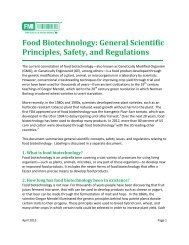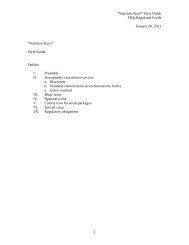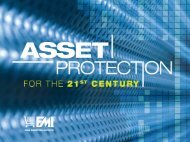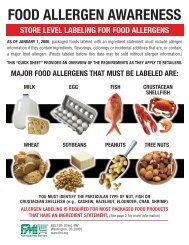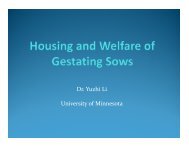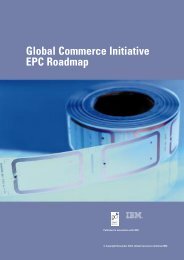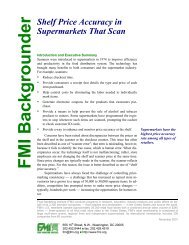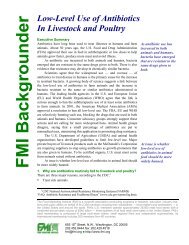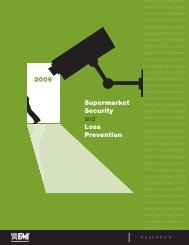Plastic Grocery Bags â Challenges and Opportunities
Plastic Grocery Bags â Challenges and Opportunities
Plastic Grocery Bags â Challenges and Opportunities
You also want an ePaper? Increase the reach of your titles
YUMPU automatically turns print PDFs into web optimized ePapers that Google loves.
<strong>Plastic</strong> <strong>Grocery</strong> <strong>Bags</strong> —<strong>Challenges</strong> <strong>and</strong> <strong>Opportunities</strong>Why <strong>Plastic</strong> Bag Waste Is Drawing Public AttentionThe best-documented environmental issues against plastic bags are visual: they litter thel<strong>and</strong>scape, clog waterways <strong>and</strong> endanger wildlife. <strong>Plastic</strong> bags take hundreds of years todecompose, <strong>and</strong> recycling rates are low.People are concerned about unsubstantiated reports of high rates of yearly shoppingplastic bag use, which suggest up to 1 trillion <strong>and</strong> more bags are used worldwide <strong>and</strong> 100billion in the U.S. These estimates are given without supporting research. The U.S. EnvironmentalProtection Agency (EPA) does not track plastic shopping bag use or waste. EPAexperts are not aware of any reliable estimates of use in the U.S. 1To curb plastic shopping bag use, some countries have imposed taxes <strong>and</strong> bans. U.S.citizen <strong>and</strong> anti-litter organizations, largely in coastal regions, are proposing stepped-up recycling,reuse incentives, disposal fees, recycled-content requirements <strong>and</strong> taxes.In 2007, San Francisco implemented America’s first partial ban of plastic bags, requiringlarge food retailers <strong>and</strong> drug stores to provide customers with only paper bags madeof 40 percent recycled content, compostable plastic bags or reusable bags. 2Environmentally, ‘Paper or <strong>Plastic</strong>?’ Is No Longer the QuestionCompared with plastic bags, paper shopping bags make a much larger carbon footprintfrom production through recycling. For example: 3• A paper bag requires four times more energy to produce than a plastic bag — 2,511BTUs vs. 594 BTUs.• In the manufacturing process, paper bags generate 70 percent more air <strong>and</strong> 50 timesmore water pollutants than plastic bags.• Nearly twice as much energy (91 percent) is required to recycle a pound of paperthan a pound of plastic.• Paper bags take up more l<strong>and</strong>fill space <strong>and</strong> weigh much more. In fact, 2,000 paperbags weigh 280 pounds, compared with 30 pounds for 2,000 plastic bags, increasingthe fuel consumed <strong>and</strong> the air pollution generated to transport them.1 Many reports cite a Wall Street Journal estimate that 100 billion bags are used in the U.S. each year <strong>and</strong> 500 to 1 trillionworldwide. A search of the newspaper’s archive over the past five years uncovered no articles substantiating these figures.Other reports cite an EPA estimate that 81-100 billion plastic shopping bags are used yearly in the U.S. Since theEPA does not track shopping bag use, paper or plastic, this figure lacks any statistical basis. These figures appear to be factoidsrepeated often enough to become facts despite the absence of an original source.2 The law took effect November 1, 2007, <strong>and</strong> applies only to food retailers <strong>and</strong> drug stores with annual sales of $1 millionor more.3 EPA, “Questions About Your Community: Shopping <strong>Bags</strong> — Paper or <strong>Plastic</strong> or …?” February 28, 2006.Food Marketing Institute (FMI) conducts programs in public affairs, food safety, research, education<strong>and</strong> industry relations on behalf of its 1,500 member companies — food retailers <strong>and</strong> wholesalers —in the United States <strong>and</strong> around the world. FMI’s U.S. members operate approximately 26,000 retailfood stores <strong>and</strong> 14,000 pharmacies. Their combined annual sales volume of $680 billion representsthree-quarters of all retail food store sales in the United States. FMI’s retail membership is composedof large multi-store chains, regional firms <strong>and</strong> independent supermarkets. Its international membershipincludes 200 companies from more than 50 countries. FMI’s associate members include thesupplier partners of its retail <strong>and</strong> wholesale members.2345 Crystal Drive, Arlington, VA 22202T 202.452.8444 F 202.429.4519fmi@fmi.org • http://www.fmi.org September 2008
<strong>Plastic</strong> <strong>Grocery</strong> <strong>Bags</strong> — <strong>Challenges</strong> <strong>and</strong> <strong>Opportunities</strong>The fact that paper bags degrade much faster loses significance considering that nothingdecomposes substantially in modern l<strong>and</strong>fills — which are lined with clay <strong>and</strong> plastic<strong>and</strong> sealed from water, light, oxygen <strong>and</strong> other elements to prevent materials from breakingdown <strong>and</strong> leaching into the environment. <strong>Plastic</strong> bags could be a greener alternative to paperones if recycling rates increase significantly <strong>and</strong> littering is controlled.In the broadest environmental sense, the checkout question “Paper or plastic?” nolonger has a simple answer. Leading environmental groups <strong>and</strong> green-minded retailers <strong>and</strong>shoppers are turning to a third choice: reusable bags.A Short History of the <strong>Plastic</strong> <strong>Grocery</strong> BagIn 1977, plastic grocery bags were introduced to U.S. supermarkets as an alternative to paperones. The convenient versions with h<strong>and</strong>les (“T-shirt” bags) followed five years later,<strong>and</strong> by 1996 four in five grocery bags were plastic — the ratio that exists today. 4 Made ofhigh-density polyethylene (HDPE) from natural gas, modern plastic grocery bags arelightweight <strong>and</strong> can carry heavy loads without breaking. These bags can be recycled to helpproduce building materials <strong>and</strong> plastic bags.<strong>Plastic</strong> bags made from recycled resins offer significant environmental benefits in theproduction process, compared with bags made from virgin resins, according to UnitedKingdom reports: two-thirds less energy is consumed, 90 percent less water is used <strong>and</strong>two-<strong>and</strong>-one-half times less carbon dioxide is released into the atmosphere. 5More recently, manufacturers introduced degradable plastic bags of two general types:• Biodegradable plastic — made from cornstarch, soy beans <strong>and</strong> other plant-based materials.• Degradable plastic — resin-based <strong>and</strong> manufactured with a chemical additive thatspeeds degradation.These types of bags do not degrade significantly in l<strong>and</strong>fills; they do degrade whenmish<strong>and</strong>led as litter <strong>and</strong> exposed to the elements required for decomposition. Waste managementcompanies are starting to provide special composting facilities, which can processbiodegradable bags. Neither type can be recycled.As a result, companies <strong>and</strong> communities considering degradable bags should ensurethat composting plants are accessible <strong>and</strong> provide a system for separating degradable bagsfrom recyclable ones.Government Campaigns to Address <strong>Plastic</strong> Bag IssuesMounting concerns over the environmental impact of plastic bags are prompting state <strong>and</strong>local governments to take action. California became the first state to address this issue withthe <strong>Plastic</strong> Bag Recycling Act of 2006, designed to curb the use of an estimated 19 billionbags per year in the state. The law requires supermarkets <strong>and</strong> large drug stores to instituteplastic bag recycling programs <strong>and</strong> make reusable bags available. Among other provisions,the statute requires stores to:• Provide bins to collect used plastic bags.• Print on each bag the message “Please Return to a Participating Store for Recycling.”• Maintain records for at least three years documenting recycling activities.4 The Society of the <strong>Plastic</strong>s Industry, Film <strong>and</strong> Bag Federation, “History of the <strong>Plastic</strong> Bag,”www.plasticsindustry.org/about/fbf/environment.htm#plasticbaghistory (visited April 4, 2008).5 Waste Online, “<strong>Plastic</strong>s Recycling Information Sheet,” p. 4,www.wasteonline.org.uk/resources/InformationSheets/<strong>Plastic</strong>s.htm (visited April 4, 2008).Food Marketing Institute 2
<strong>Plastic</strong> <strong>Grocery</strong> <strong>Bags</strong> — <strong>Challenges</strong> <strong>and</strong> <strong>Opportunities</strong>Since then, more than 40 states, counties <strong>and</strong> cities considered legislation to institutem<strong>and</strong>atory or voluntary plastic bag recycling programs, impose a tax on bags or ban theiruse. Illinois <strong>and</strong> Rhode Isl<strong>and</strong> enacted m<strong>and</strong>atory recycling laws, along with the cities ofNew York <strong>and</strong> San Juan Capistrano, CA, <strong>and</strong> Los Angeles County, CA, <strong>and</strong> SuffolkCounty, NY.Many cities in California pursued plastic bag bans in 2007. All of these measureswere defeated except the one enacted by San Francisco. Oakl<strong>and</strong> enacted a similar ban,which was overturned by a court ruling that the city must conduct an environmental impactstudy before moving forward with the law. Opponents argued that a ban could increase useof paper bags, which generate more pollution <strong>and</strong> consume more energy to produce <strong>and</strong> recyclethan plastic bags. 6 Efforts to legislate bans were also defeated in the states of Hawaii,Maryl<strong>and</strong>, Washington <strong>and</strong> Wisconsin.The movement is continuing in 2008. Measures to ban plastic bag use are pending inConnecticut, New Jersey, Pennsylvania, Rhode Isl<strong>and</strong> <strong>and</strong> West Virginia. Others areweighing taxes on each bag used, including Alaska, Pennsylvania <strong>and</strong> Vermont. Seattle ispursuing a broader tax, recognizing the adverse environmental impact of plastic <strong>and</strong> paperbags. The city council enacted an ordinance imposing a 20-cent fee on all disposable shoppingbags at grocery, drug <strong>and</strong> convenience stores. In this approach, retailers would receive5 cents of each fee to cover administrative costs, <strong>and</strong> the balance would help fund city programsto promote reusable bags, waste reduction <strong>and</strong> recycling. 7 This law is due to take effecton January 1, 2009.How U.S. Manufacturers <strong>and</strong> Retailers Are Addressing <strong>Plastic</strong> Bag Use<strong>Plastic</strong> bag manufacturers are following the lead of the Progressive Bag Affiliates (PBA), adivision of the American Chemistry Council. PBA’s mission is to “initiate programs thathelp businesses <strong>and</strong> consumers reduce, reuse, recycle <strong>and</strong> properly dispose of plastic bags.”It is working to prevent plastic bag bans, taxes <strong>and</strong> other legislative initiatives to curb theuse of disposable <strong>and</strong> recyclable plastic bags.In part through PBA educational efforts, anti-plastic bag legislative issues emerging incommunities are resolved by raising citizen awareness about the benefits of recycling <strong>and</strong>reusing plastic bags. For example, in 2007 after much collaboration among legislators, bagmanufacturers <strong>and</strong> the PBA, the Suffolk County legislature rejected a proposed ban in favorof a plastic bag recycling law.Food retailers across America are engaged in multiple efforts to encourage recycling,bag reuse <strong>and</strong> decreased reliance on plastic shopping bags. For the past 30 years, most U.S.food retailers have offered customers a choice of either plastic or paper bags. Many supermarketsprovide recycling receptacles for used plastic bags. They are exp<strong>and</strong>ing plastic bagrecycling programs, providing plastic <strong>and</strong> paper bags with recycled content, <strong>and</strong> offeringcustomers a credit ranging from 1-10 cents for each bag reused.In fact, more than nine in 10 food retailers (93.5 percent) offer reusable shopping bagsfor sale, <strong>and</strong> half of their customers (51 percent) use these bags at least one to three times amonth. 8 Many retailers are training employees to fill bags fuller <strong>and</strong> minimize doublebaggingto reduce the number of bags used.6 Huus, Karl, “<strong>Plastic</strong>s Industry Battles <strong>Grocery</strong> Bag Bans,” MSNBC, March 14, 2008.7 Chan, Sharon Pian, “Seattle Officials Propose 20-Cent <strong>Grocery</strong>-Bag Fee,” Seattle Times, April 3, 2008.8 FMI, U.S. <strong>Grocery</strong> Shopper Trends 2008, p. 96; The Food Retailing Industry Speaks 2008, p. 62.Food Marketing Institute 3
<strong>Plastic</strong> <strong>Grocery</strong> <strong>Bags</strong> — <strong>Challenges</strong> <strong>and</strong> <strong>Opportunities</strong>One success story demonstrates how government <strong>and</strong> retailers can together make adifference voluntarily. In November 2007, the city of Phoenix, AZ, encouraged customersto use reusable shopping bags by distributing 30,000 free bags. The city launched this programin a partnership with the Arizona Food Marketing Alliance <strong>and</strong> Wal-Mart, Inc. Storesbuilt special displays announcing this Bag Central Station program <strong>and</strong> h<strong>and</strong>ed out the reusablebags. 9Consumers Growing More Aware of <strong>Plastic</strong> Bag IssuesUntil recently, the lack of consumer awareness has fueled the litter debate <strong>and</strong> dem<strong>and</strong>s tocurb plastic bag use. There are indications that consumer sentiment is changing. Retailersacross America report that consumer dem<strong>and</strong> for reusable bags is increasing. 10In 2007, five FMI supermarket companies operating nearly 1,700 stores tracked consumercomments about bag use during various times throughout the year. These were unsolicitedcomments coming into their consumer affairs or corporate offices. They received148 requests that their stores provide reusable bags, <strong>and</strong> 121 suggested that they offer consumerincentives for using these bags. Smaller numbers expressed a preference for paper(83) <strong>and</strong> degradable plastic bags (24).The Growing Market for Recycled <strong>Plastic</strong>There is a growing market for recycled plastic that did not exist 15 years ago. Recyclers canearn 15-20 cents per each pound of plastic bags recovered. It is less expensive to use recycledplastic resins than virgin resins, increasing the potential for recycling more plasticbags. Recycled plastic bag resins are used to make shopping bags, shopping carts <strong>and</strong> baskets,decking boards, pallets, patio pavers, laundry baskets, parking lot speed bumps, carstops <strong>and</strong> many other products.With recycled plastic bags worth about $400 per ton, increasing recycling at all levelspresents a viable opportunity for food retailers <strong>and</strong> partnering municipalities. More than1,800 U.S. businesses recycle post-consumer plastics, <strong>and</strong> most are food retailers. In 2006,an estimated 812 million pounds of post-consumer film, including plastic bags, were recoveredfor recycling — a 24 percent increase over the previous year. 11 These figures shouldincrease as more states, counties <strong>and</strong> cities institute plastic bag recycling programs.Increasing the recycling of plastic bags requires a variety of strategies. The followingcompanies offer examples of current technologies used to produce bags <strong>and</strong> other productsfrom recycled plastic <strong>and</strong> other products:• AERT (Advanced Environmental Recycling Technologies, Inc.) has pioneered theuse of recycled polyethylene plastic to manufacture composite building materialssince 1989. The company is recognized as a leader in resource conservation innovation,receiving the EPA Award for Environmental Excellence in 1999 for its processof converting scrap plastic into composite outdoor decking. AERT converts reclaimedplastic <strong>and</strong> wood fiber waste into outdoor decking systems, fences <strong>and</strong> door<strong>and</strong> window components. It operates manufacturing facilities in Springdale, Lowell,<strong>and</strong> Tontitown, AR; Junction, TX; <strong>and</strong> Alex<strong>and</strong>ria, LA. (www.aert.com)9 EV Living, Phoenix News, “City Distributes 30,000 Reusable <strong>Bags</strong> to Promote Reduction in <strong>Plastic</strong> Shopping <strong>Bags</strong>,”November 29, 2007.10 Carr, Coeli, “In the Bag: A Greener Checkout,” Supermarket News, December 1, 2007, p. 20.11 Moore Recycling Council Associates, 2006 National Post-Consumer Recycled <strong>Plastic</strong> Bag <strong>and</strong> Film Report, preparedfor the <strong>Plastic</strong>s Division of the American Chemistry Council.Food Marketing Institute 4
<strong>Plastic</strong> <strong>Grocery</strong> <strong>Bags</strong> — <strong>Challenges</strong> <strong>and</strong> <strong>Opportunities</strong>• Trex has been turning millions of pounds of recycled <strong>and</strong> reclaimed plastic <strong>and</strong> wastewood each year into decks, rails, fences <strong>and</strong> trim since 1996. Most of the raw materialscome from recycled plastic bags, other plastic waste <strong>and</strong> hardwood sawdust. Thecompany recycles 1.5 million plastic bags a year <strong>and</strong> reports that the volume is increasingas more cities <strong>and</strong> states promote recycling with education, waste managementprograms <strong>and</strong> laws. 12 (www.trex.com)• NextLife, an alliance of recyclers <strong>and</strong> manufacturers, recycles plastic grocery bags<strong>and</strong> other materials into bags <strong>and</strong> other products. Mountain Valley Recycling <strong>and</strong>NextLife jointly develop closed-loop programs in which plastic is continuously reusedto make products. Mountain Valley’s technology transforms plastic waste into100 percent certified post-consumer grade resins <strong>and</strong> durable plastic products.(www.mvrecycling.com)• Hilex Poly Co. operates a “Bag-2-Bag ® ” recycling center in North Vernon, IN, thatrecycles used plastic bags into new ones. In the first quarter of 2008, it recovered approximately3 million pounds of plastic resins from used bags <strong>and</strong> produced 150 millionnew bags. The company is partnering with three California cities — Dana Point,San Clemete <strong>and</strong> San Juan Capistrano — to collect plastic bags in curbside recyclingprograms for nearly 40,000 households. It provides supermarkets with plastic bagcollection bins, along with systems to help them count bags, ensure that bags arefully packed <strong>and</strong> reduce their use. (www.hilexpoly.com/bag2bag.htm)International Efforts to Curb <strong>Plastic</strong> Bag UseMany countries have undertaken aggressive campaigns to reduce plastic shopping bag use<strong>and</strong> ban all plastic bags or ultra-thin ones (less than 30 microns thick), which are a majorsource of litter <strong>and</strong> cannot be reused or recycled. For example:Among African nations, South Africa was the first to act by banning ultra-thin plasticbags <strong>and</strong> imposing taxes on thicker ones in 2003; Kenya <strong>and</strong> Ug<strong>and</strong>a followed suit in2007. Eritrea, Rw<strong>and</strong>a <strong>and</strong> Somalia banned all plastic bags in 2005, as did Tanzania (includingZanzibar) the following year. 13Australia began taking action in 2002. The nation’s Environmental Protection <strong>and</strong> HeritageCouncil (EPHC) set a goal to phase out single-use bags by the end of 2008. The AustralianRetailers Association adopted a Code of Practice for the Management of <strong>Plastic</strong><strong>Bags</strong> in 2003, including a commitment by major supermarkets to a 50 percent reduction inHDPE bags by end of 2005. Industry <strong>and</strong> government campaigns to promote reusable bags<strong>and</strong> recycling <strong>and</strong> dissuade shoppers from using single-use ones produced significant results.<strong>Plastic</strong> bag consumption declined from 6.9 billion in 2002 to 3.9 billion in 2005. 14Debate continues over how to achieve further reductions such as through bans, taxes or surcharges.Some jurisdictions have taken independent action, including bans.12 Blake, Whitney, “Trex Sees 20 Percent Increase in <strong>Plastic</strong> Recycling,” The Examiner (Washington, DC), April 3, 2008, p. 17.13 BBC News, “<strong>Plastic</strong> bag bans around the world,” February 28, 2008, http://news.bbc.co.uk/2/hi/in_depth/7268960.stm(visited April 9, 2008).14 Environmental Protection <strong>and</strong> Heritage Council, Consultation: Regulatory Impact Statement — Investigation of Optionsto Reduce the Environmental Impact of <strong>Plastic</strong> <strong>Bags</strong>, January 2007, pp. 17-18.Food Marketing Institute 5
<strong>Plastic</strong> <strong>Grocery</strong> <strong>Bags</strong> — <strong>Challenges</strong> <strong>and</strong> <strong>Opportunities</strong>In Canada, Leaf Rapids, Manitoba, became the country’s first city to ban plastic bags,starting in April 2007. 15 Ontario is moving to reduce plastic bag use with incentives, workingwith the Recycling Council of Ontario <strong>and</strong> grocer <strong>and</strong> retail associations. The incentivesinclude store points redeemable for products, airline miles or cash for consumers who usereusable bags. Retailers are training clerks to double-bag less often, fill bags with moreitems <strong>and</strong> stop bagging large items. 16China is prohibiting all supermarkets, department stores <strong>and</strong> other retailers from providingcustomers free plastic bags, effective June 1, 2008. Retailers are required to charge customersfor any bags they use at a rate equal to the cost. The country banned altogether the useof ultra-thin plastic bags, which have become a major source of litter. Retailers that violatethis requirement could face fines of up to 10,000 yuan ($1,431). 17In Europe, Irel<strong>and</strong> was the first to take action, imposing what became know as a “plastax”on plastic shopping bags, introduced in 2002 at 0.15 euros per bag <strong>and</strong> increased in 2007 to0.22 euros (equaling about 34 cents 18 ). This tax reduced plastic bag use in the country bynearly 90 percent. 19 Today, plastic bags are also taxed in Italy <strong>and</strong> Belgium, <strong>and</strong> shoppersmust pay for them in Switzerl<strong>and</strong>, Germany <strong>and</strong> Holl<strong>and</strong>. Spain, Norway <strong>and</strong> the U.K.are considering bans or taxes. 20<strong>Plastic</strong> Bag Recycling Information <strong>and</strong> Education ResourcesBest Practices Guide for At-Store Collection of <strong>Plastic</strong> <strong>Bags</strong> — Prepared by Canada’sEnvironment <strong>and</strong> <strong>Plastic</strong>s Industry Council, this guide shows retailers how to develop atstorecollection program for plastic bags. It brings together practices already used in manyretail outlets throughout North America.The Environment <strong>and</strong> <strong>Plastic</strong>s Industry Council, Canadian <strong>Plastic</strong>s Industry Association905-678-7748, www.plastics.ca/epicPenn Jersey’s Bag Smart <strong>Plastic</strong> Bag Reduction <strong>and</strong> Recycling Model Penn Jersey —This Philadelphia-based retail equipment <strong>and</strong> supplies company manages “Bag Smart,” aplastic bag <strong>and</strong> recycling initiative in partnership with Goodwill, Trex <strong>and</strong> participatingbusinesses <strong>and</strong> retailers. The program features store bagging training tips, bag reuse ideas,plastic bag recycling solutions, consumer education <strong>and</strong> reusable plastic bag offers.Penn Jersey Paper Company — 800.992.3430, www.pjponline.comProgressive Bag Affiliates At-Store <strong>Plastic</strong> Bag Recycling Collection Toolkit — Thisresource provides retailers with a step-by-step process to implement an at-store bag recyclingprogram including instructions on bag language (including language required bylaws), setting up collection bins, signage, bag consolidation, sale of material <strong>and</strong> consumereducation materials. www.plasticbagrecycling.org15 CBC News, “It’s Official, Manitoba Town Gives <strong>Plastic</strong> the Boot, April 2, 2007.16 CTV, “Ontario Launches Program to Cut <strong>Plastic</strong> Bag Use, May 9, 2007.17 Associated Press, “China Bans Free <strong>Plastic</strong> Shopping <strong>Bags</strong>,” published in the International Herald Tribune on January9, 2008; China Daily, “Shops face fines for free plastic shopping bags,” April 8, 2008. The conversion of yaun to dollarsis based on the exchange rate as of April 22, 2008.18 Based on the euros-dollars exchange rate in April 2008.19 “Irish Bag Tax Hailed Success,” BBC News, August 20, 2002; RTE News, “One <strong>Plastic</strong> Bag Now Costs 22c,” July 1, 2007.20 Roach, John, “<strong>Plastic</strong>-Bag Bans Gaining Momentum Around the World,” National Geographic News, April 4, 2008,http://news.nationalgeographic.com/news/pf/74875718.html (visited April 9, 2008).Food Marketing Institute 6
<strong>Plastic</strong> <strong>Grocery</strong> <strong>Bags</strong> — <strong>Challenges</strong> <strong>and</strong> <strong>Opportunities</strong>Additional Sources of Information About <strong>Plastic</strong> Bag IssuesAmerican Chemistry Council, <strong>Plastic</strong>s Division, Progressive Bag Affiliates —703.741.5000, www.americanchemistry.com/plastics/Commonwealth of Australia Department of the Environment <strong>and</strong> Water Resources<strong>Plastic</strong> Shopping <strong>Bags</strong> in Australia report by the National <strong>Plastic</strong> <strong>Bags</strong> Working Groupto the National Packaging Covenant Council —www.environment.gov.au/settlements/publications/waste/plastic-bags/report-2002.htEnvironmental Advocacy GroupsEnvironmental Defense Fund — 800.684.3322, www/edf.orgNatural Resources Defense Council — 212.727.2700, www.nrdc.orgSierra Club — 415.977.5500, www.sierraclub.org,World Wildlife Fund — 202.293.4800, www.worldwildlife.orgFilm <strong>and</strong> Bag Federation — 202.974.5218, www.plasticbag.com<strong>Plastic</strong> Bag Manufacturers, U.S.Advance Polybag — 800.504.5000, www.apicorp.comInterplast — 800.896.3222, www.ibsbags.comSuperbag — 888.842.1177, www.superbag.com<strong>Plastic</strong> Bag <strong>and</strong> Film Manufacturers <strong>and</strong> RecyclersHilex Poly Co. — 800.432.1050, www.hilexpoly.comMountain Valley Recycling, LLC — 561.274.4928, www.mvrecycling.comNextLife, Inc. — 877.214.0501, www.nextlifeinc.comTrex — 800.289.8739, www.trex.comThe Society of <strong>Plastic</strong>s Industry — 202.974.5200, www.plasticsindustry.orgUse Less Stuff — Publisher of the ULS Report, www.use-less-stuff.comU.S. Environmental Protection Agency Websiteswww.epa.gov/msw/paper.htmwww.epa.gov/msw/faq.htmwww.epa.gov/epaoswer/non-hw//muncpl/pubs/mswchar05.pdf“Questions About Your Community: Shopping <strong>Bags</strong> — Paper or <strong>Plastic</strong> or …?”http://web.archive.org/web/20060426235724/http://www.epa.gov/region1/communities/shopbags.htmlFood Marketing Institute 7
<strong>Plastic</strong> <strong>Grocery</strong> <strong>Bags</strong> — <strong>Challenges</strong> <strong>and</strong> <strong>Opportunities</strong>Glossaryadd-on packaging — a term used to describe any carryout bag or extra packaging providedby retailers.biodegradable plastics — plastics that decompose in the natural environment <strong>and</strong> can includenon-carbon-emitting starch-based plastics or oil-based plastics, which release carbondioxide.bioplastic — plastic derived from plant sources such as hemp oil, soy bean oil <strong>and</strong> cornstarch or from a microbial source, rather than traditional plastics, which are derived frompetroleum.closed-loop recycling — reuses recovered plastics to manufacture new 100 percent postconsumerrecycled products.compostable — made from biodegradable substances capable of degrading in a properlymanaged compost process.degradable plastic — plastic able to be broken down by mechanisms such as bacterial action,exposure to heat, light or oxygen within a short time frame.high-density polyethylene — HDPE is a thermoplastic made from natural gas <strong>and</strong> hasstronger tensile strength than low-density polyethylene (LDPE). HDPE plastic bags are recyclable<strong>and</strong> widely used in supermarkets.life-cycle assessment — LCA (also known as a life cycle analysis, ecobalance or cradle-tograve-analysis)is the investigation <strong>and</strong> valuation of the environmental impacts of a givenproduct or service caused or necessitated by its existence. The goal of an LCA is to comparethe full range of environmental damage assignable to products <strong>and</strong> services, to be ableto choose the least burdensome one.low-density polyethylene — LDPE is a thermoplastic made from natural gas, <strong>and</strong> its mostcommon use is for plastic bags. LDPE bags are softer to h<strong>and</strong>le <strong>and</strong> more pliable thanHDPE bags.non-government organization — NGO is a legally constituted organization created byprivate persons or organizations with no participation or representation of any governmententity.photodegradable or photodegradation — degradation caused by sunlight, <strong>and</strong> includesthe breakup of molecules into smaller pieces by photons. For example, six-pack soda canrings have been photodegradable LDPE plastic since the 1990s. Some plastic bags aremanufactured with properties making them photodegradable.polyethylene terepehthalate — PET is a thermoplastic polymer resin of the polyester family<strong>and</strong> is commonly used in the manufacture of soft drink bottles.Food Marketing Institute 8
<strong>Plastic</strong> <strong>Grocery</strong> <strong>Bags</strong> — <strong>Challenges</strong> <strong>and</strong> <strong>Opportunities</strong>post-consumer recycled-content — a product containing post-consumer recycled materialor a percentage of this content derived from curbside or other community recycling programs,if viewed as more beneficial, <strong>and</strong> helps support recycling as a solution.recycled-content paper bags — paper grocery bags manufactured with up to 100 percentrecycled fibers. Recycled papers may not be as strong as paper made from virgin fibers.recycled-content plastic bags — primarily LDPE bags manufactured from a combinationof recycled plastic resins <strong>and</strong> virgin resins. Recycled-content can comprise up to 100 percentof the material content of each bag.renewable resource — a resource that has the ability to regenerate at regular intervals.reusable bags — manufactured from strong durable materials that extend the life of thebag, eliminating waste from frequent disposal.single-stream recycling — curbside recycling programs that combine all material typesinto one collection container, compared with “single-sort” or “source-separated” recyclingin which glass, metal, plastic <strong>and</strong> paper are placed in separate containers.thinned-walled plastic bags — disposable shopping or carryout bags, usually manufacturedfrom high-density polyethylene (HDPE) or low-density polyethylene (LDPE).waste-to-energy — WTE or energy-from-waste (EFW) refers to any waste treatment thatcreates energy in the form of electricity <strong>and</strong>/or heat from a waste source. In states <strong>and</strong>communities that have built reliance on waste-to-energy plants as strategic solutions forwaste disposal, plastic bags as a source of waste energy may be more attractive to recyclersor processors.Food Marketing Institute 9




